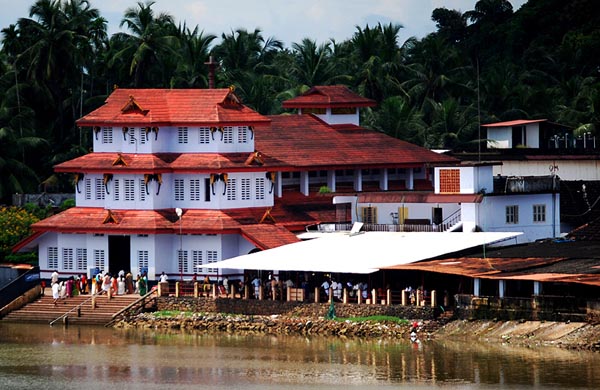Parassinikadavu Muthappan Temple

Information of Parassinikadavu Muthappan Temple, Kannur, Kerala
Parassinikadavu Muthappan temple is situated on the banks of the river Valapattanam located at a distance of about 10 kilometers from Taliparamba in the Kannur district of Kerala. The principal deity of the temple is Sree Muthappan who is considered to be a mix of two deities namely Thiruvappana and Vellattam. This deity is not mentioned in the Vedas therefore is a local deity conjured up by the locals of the erstwhile time. This temple is special and unique in form of its offerings which can be hardly seen in other Hindu temples.
Parassinikadavu Muthappan Temple Religious Significance
This temple is one of those Hindu places of worship that does not recognize the "Satvic Brahminical" form of worship. The worship of the principal deity is also carried out by a ritualistic dance or enactment of the two characters that Muthappan is made up of. The offerings to the deity is also peculiar as compared to the other Hindu temples in Kerala, here offerings of fish, meat and toddy are made. There were also dogs being donated to the temple but of late this custom has stopped.
The daily rituals include the enactment of the characters Muthappan is made of and is performed during the early mornings and evenings. The main festival of the temple is carried out on the month of Kumbham according to the Malayalam calendar. It is celebrated for three days on the 19th, 20th and 21st of the Kumbham month and is known as Muthappan Thiruvoppana Mahaotsavam.
Other festivals celebrated here are the harvest festivals which are celebrated on the Malayalam month of Vrichikam and are called Puthari Thiruvappana. The first festival is celebrated on the 16th day of the month and usually corresponds to the 1st or 2nd December in the Gregorian calendar and the second one on the 30th of Kanni in the Malayalam calendar.
Parassinikadavu Muthappan Temple architecture
There is no mention of any legends in the Vedas or the other religious texts but there are a number of folklores associated with it. One of the most widely known one is that of a Brahmin family in the Pavyavoor. It is said that the wife of the Brahmin, Padikutty Antharjanam found a baby floating in the river and she took it as a blessing from Lord Shiva of whom she was an ardent devotee. It is said that the couple had no children and was happy to take this baby in. The child grew up in a Brahmin centered culture but he learned hunting and started eating flesh during his boyhood. This was taboo according to the Brahmin culture, when he was stopped by his mother, the boy in anger revealed his true form of a god. The mother bowed in reverence to the boy after seeing this and told him to cover his eyes with a Poikannu for fear that the fiery look in his eyes would release cosmic forces that could kill a human. After this day the boy left the village and his family passing through places such as Kunnathurpadi, Puralimala, Padavil, Thillenkeri, Kannapuram, Parassinikadavu and Valluvankadav which are in Malabar.
The name Muthappan is said to have come when he cursed a tribal man who denied him toddy. He was then in a village called Kunnathurpadi and had befriended the same tribal man. This tribal man was turned into stone after being cursed. His wife prayed to him and offered him toddy in her rituals on which the boy gave her husband back. The family then started performing pooja to please the boy and named him Muthappan.
It is also believed that a dog always followed him throughout his journey and therefore there is an idol of a dog on both sides of the principal deity. The mythological significance is of great importance as well as the holiness which makes it an important temples of South India.
Parassinikadavu Muthappan Temple architectural Significance
The temple is located on the banks of the river and is built in the classical Kerala style architecture with overlapping sloping roofs, corridors and a sanctum sanctorum.
- Andhra Pradesh Temples
- Assam Temples
- Bihar Temples
- New Delhi Temples
- Goa Temples
- Gujarat Temples
- Jammu and Kashmir Temples
- Karnataka Temples
- Kerala Temples
- Madhya Pradesh Temples
- Maharashtra Temples
- Odisha Temples
- Punjab Temples
- Rajasthan Temples
- Sikkim Temples
- Tamil Nadu Temples
- Telangana Temples
- Uttar Pradesh Temples
- Uttarakhand Temples
- West Bengal Temples